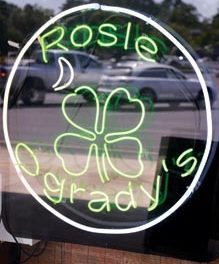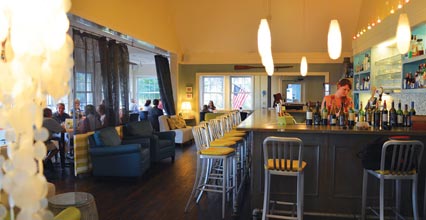The Winos chat with the Vice Chairman of Terlato Wines
Over the past two years, Terlato Wines International has received more than 700 90+ ratings – more than any wine import company in the world. As the world’s best luxury wine importer with a global portfolio of more than 50 brands, Terlato markets more than one out of eight bottles of wine over $14 sold in America. We went to an amazing tasting of nearly 60 of their wines in Charleston, which we would call the “best wine tasting of our lives, to date.”
We spoke with Terlato Vice Chairman John Terlato in the wine cellar at Breakwater Restaurant in Beaufort. At the time, John was on his way to an event on Spring Island, where his brother has a home.
Happy Winos: John, it’s a real honor to have you here at Breakwater. You, your father and brother have virtually transformed the luxury wine business in America over the past 50 years. Your father was the first to introduce the varietal Pinot Grigio into America with your bestselling Santa Margherita. Is there a word or phrase that sums up your family’s philosophy of success?
John Terlato: Without question it would be “Quality endures.” In fact, our motto is: Consider quality a way of life. We do. The pursuit of quality is not only what drove my father throughout his career – from the retail store to the distributing business to marketing fine wines – but it is also what guides and drives my brother and me and our entire team today. If one looks at the portfolio of wines we offer (I call it an embarrassment of riches) he/she would find this same commitment to quality. In our portfolio are some of the finest wines the world has to offer and these wines (and their owners) have five common threads: 1. A total commitment to quality; 2. Passion for wine and winemaking; 3. An unbelievably talented and visionary winemaker; 3. Amazing soil (no substitutes here!); 4. Best in class farming capabilities and practices (in the tough vintages the great farmers wine!); and 5. Family owned and operated. In 1996, when we purchased our first winery, we had the opportunity to apply this intense focus on quality to winemaking as well – which has been great fun. The results, at Rutherford Hill, Chimney Rock, Sanford, Alderbrook and Terlato Family Vineyards, are stunningly rewarding. These unbelievable, hand-crafted wines are just delicious!! Our goal is to produce wines that are complex yet subtle, powerful, yet elegant. I believe this is the true art of winemaking. How cool is that?
HW: How does your company keep its competitive edge in such a crowded wine world… How do you consistently ‘knock it out of the ballpark’?
JT: I hate being redundant, but it all comes back to quality – and being genuine. When we are making decisions about wines to offer to consumers or wines we might craft from our vineyards, we focus on four elements:
1. Is the quality and consistency there, year in and year out? If a winemaker and/or vineyard is producing wines of great variability in taste and/or quality, the consumer will recognize this disconnect. Consistent high quality winemaking gets you in the gate. I am NOT referring to vintage variability, I am talking about quality variability – there is a huge difference.
2. How will this wine exist at the table? We always think about food – “not that there’s anything wrong with that!” How will this wine perform on the table with food? That’s where most wines are enjoyed, and where you may have had some of your most memorable wine moments (that you can speak of in polite company).
3. Price/value relationship: Will the consumer believe this wine is a good value at its given price? Consumers are super smart – they possess a visceral responsiveness to price paid versus value. Simple: “this wine was a great buy at that price” or, “I wouldn’t purchase that wine again—it wasn’t worth it.” We taste our wines double blind and we force rank the wines alongside wines that are $10 to $15 more expensive per bottle. If our wines score well in that double blind tasting against more expensive competitors, it’s likely a consumer will recognize that value. This is a really demanding discipline but we do this for every wine we are associated with. Tough job, but someone has to do it!
4. Genuineness – Is this wine a true representation of the varietal (be it Pinot Noir, Cabernet, Merlot etc) as the varietal was meant to be? Pinot Noir is this beautiful, sexy, seductive varietal with incredible subtlety. Yet, it possesses great depth and character. If a winemaker honors the intrinsic subtleties of the varietal and its characteristics, then the consumer can enjoy those subtleties and complexities as they were meant to be. If, on the other hand, a winemaker engineers a varietal into something it was not meant to be (engineering Pinot Noir to be highly extracted and high alcohol as a substitute for Syrah or Cabernet for instance) well…it’s engineered. Grapes should be cultivated – not engineered! Life is too short to drink engineered wines.
These reference points allow us to “knock it out of the park.” It’s not really an original thought, but quality is quality and most consumers can tell the difference between “great” and “just ok.” We are wine consumers as well, and in most instances probably really demanding wine consumers.
But perhaps most important is innovation, hard work and an unbelievable team of dedicated, honest, solution driven people who are totally passionate about wine and food. These are the ingredients that make up our success.
HW: With 700 wines in your award winning portfolio, what’s your personal house red and house white that you are drinking right now?
John Terlato: Yikes! Are you kidding me? That’s like asking me which one of my children I love the most!! So the real answer is – are you ready? – all of them! Every dinner presents a new opportunity to share a wine or wines with my friends and family. It just depends on the moment… the food, the people who will be joining us at the table, the weather, bathing suits or jackets and ties, etc. Some days it’s Burgundy; others, Rhone. And then there is Australia and South Africa – Yum!! Don’t forget California Sauvignon Blanc or Italian Pinot Grigio!! Then sometimes, I just feel like having a bottle of Barbaresco or a big California red. Really depends on my mood. I guess you can say I am moody about my wine. So many wines… so little time!
HW: What’s the best bottle you’ve ever tasted?
JT: Wow, another tough question… this interview was supposed to be easy! Well let’s see, the setting and the place certainly had an impact on my decision… the bottle of unbelievable Vintage Rose Champagne (Bollinger) shared with my girlfriend at the time, consumed with the most delectable smoked salmon from the outer Hebrides on the evening I asked her to marry me. Yep – that would be it!! That is my final answer – no lifeline needed.
HW: We know your company has an amazing focus on correct wine and food pairings. Can you give our readers a few of your favorite food and wine pairing tips?
JT: 1. Trust your palate. When you eat a great piece of fish or a fabulous slab of ribs, or an unbelievable lamb chop – your mouth, head, stomach and taste buds know it. Trust those same instincts when it comes to pairing food and wine. If the food and wine together is enjoyable in your mouth, it’s probably a good match.
2. Taste the same wine with different foods to see if the wine causes the food to taste more or less delicious? Does the food cause the wine to be more enjoyable or less enjoyable? I love this exercise. To further this thought; I will pour a glass of Terlato Pinot Noir for my guests, and then prepare three different salmon preparations: 1. Soy marinade; 2. Grainy mustard; 3. Olive oil, salt and pepper. I then place one of each of the servings on each person’s dish and ask my friends which salmon preparation goes well with that particular wine? It’s great fun and it really gets people thinking about how foods affect the flavor of wine and vice versa. You can almost see the light bulbs illuminate.
3. When tasting foods and wines, try to identify and/or recall flavors, smells and textures- I refer to this as palate memory. Your palate, which is the connection between flavor and smell receptors in your mouth and nose and your brain, is capable of recall if you focus on it and attempt to develop that recall capability. It’s like Sudoku – the more one practices the greater the development of the skill.
4. Read my Father’s book – TASTE: A Life in Wine. Seriously, this isn’t a plug to sell more books; we didn’t print enough of them. Each chapter concludes with a wine and food pairing. For example: The last chapter of the book gives the recipe for Lamb Loin A La Bordelaise paired with EPISODE, a wine of which we only make 400 six packs. It is a perfect pairing.
5. Don’t make it too serious – this is supposed to be fun. Have a good time with your friends and family, share great food and great wine.
HW: Breakwater Restaurant is on track to be the number one seller of M. Chapoutier wine in South Carolina. Your father discovered this legendary Rhone Valley winemaker and you import his fabulous wines to America. The bottle is also famous for it’s distinctive Braille label because the plot of land where the vineyard is located belonged to Maurice Monier de la Sizeranne, the inventor of Braille, and also winemaker Michel Chapoutier wanted to reach out to include all people with sight-impairments, who were lovers of good wines. What are your thoughts on what makes Michel such a talented winemaker?
JT: OMG – The man is brilliant; he’s a brilliant winemaker, brilliant farmer, brilliant conversationalist! And I love that he calls himself a wine lover! He is well traveled and well versed and can talk about just about anything, sex politics and religion included. Can you tell we all enjoy his company? Add a little wine and the night is off and running.
Since he took over the estate in 1990, Michel has revolutionized his family’s winery and the Rhône Valley wine industry. Innovations introduced by him have included: biodynamic viticulture, intelligent vineyard management, vintage dating for all the estate’s wines, and the elimination of fining and filtration. In fact, the biodynamic model created by Michel in the 1990s has become the standard by which the entire biodynamie industry is measured in contemporary Europe. When it comes to the concept of terroir, trailblazing winemaker Michel Chapoutier will be the first to tell you that terroir is more than just a “unique combination of climate, subsoil, and exposure to the sun.” Terroir is also about people, he will tell you, “that’s one of the reasons my family and I live among our vineyards.”
All one has to do is spend 10 minutes with Michel and you realize you are in the presence of a genius and a visionary. This man is thinking way ahead of the crowd.
HW: Any final thoughts?
JT: Sure. First, you guys are great!! I totally enjoyed your company and our time together. Second, how about a quote that my dad used in his book; it’s by Andre Simon: “Wine makes every meal an occasion, every table more elegant, and every day more civilized.” And lastly, I am so looking forward to seeing you in October for our winemaker dinner at Breakwater!!
HW: We very much look forward to your return to Beaufort!








